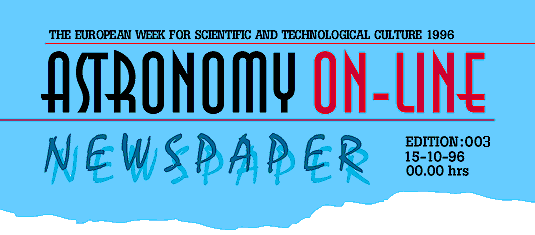

The Solar Eclipse reached almost 40 percent in Portugal. This marvellous image series is courtesy of Antonio Cidadao, Portugal, who handled all the observational tasks singlehandedly - including broadcast of the eclipse on the Internet as desrcibed below. The times for the different images are here (in UT): 13:11, 13:16, 13:21, 13:27 13:30, 13:36, 13:41, 13:46, 13:52, 13:56, 14:01, 14:06, 14:11, 14:16, 14:21, 14:26, 14:31, 14:36, 14:41, 14:46, 14:51, 14:56, 14:01, 15:06, 15:11, 15:16, 15:21, 15:26, 15:31, 15:36 and 15:41. Click on the picture to display a larger version (JPEG, 46k).
The October 12 Solar Eclipse will for sure remain a very special event in the minds of the thousands of participating Astronomy On-Line students, teachers, amateur astronomers and professionals all over Europe.
Parts of Scandinavia were clouded out during the event on Saturday, e.g. Finland, Norway, and parts of Denmark - but most of central Europe was under influence of a high-pressure region entering from the South Atlantic. Bulgaria had heavy fog. In Portugal the morning was very foggy, but the fog lifted just in time.
Here follow some impressions from the different groups around Europe:
From Toulouse in France: What a wonderful weather for this eclipse! There were plenty of people in the park where the old Observatory stands. We could see very well the luminous crescents on the ground through the leaves on the trees - and because of the strong wind, they were sweeping the ground, back and forth.
The Vienna Kuffner Group in Austria had beautiful weather conditions. Both a black box camera and a Celestron C8 Schmidt Cassegrain were applied and they had lots of visitors with them, sharing the beuatiful eclipse.
Please send your own contribution as soon as possible. Read about more results in the Bulletins during the coming days!
In La Rochelle, the group was almost overrun by people, making the measurements somewhat difficult. Nevertheless, the Rochelle Group got a distance to the Moon of 350 000 km, which is to be compared with the exact value of 390 406 km (from the "Astronomical Almanac", calculated by Bjorn Franck Joergensen, Tycho Brahe Planetarium, Denmark).
The Astronomy On-Line Gluckers Group from Neumarkt, Germany measured a value of H/W = 0,40 at 15:45 MET - implying a distance of 359 000 km.
Similar results were obtained by the Vienna Kuffner Group.
Knud Erik S°rensen from Horsens got a short break in the fog, enabling his class 2B from Horsens High School to measure H/W = 0.447 at 14:57 MET. According to the Math 2D chapter in here, this gives a parallax of 0.93 Deg. Application of the sine relation results in a distance of 348 000 km.
So far, most of the received results are within 380 000 km +/- 10 percent! Some calculated distances are a bit too high - some too low.

The Danish part of the live transmission collaboration got these 18 images of most of the eclipse. The times for the images are given here (in UT): 13:07, 13:12, 13:17, 13:22, 13:27, 13:32, 13:37, 13:42, 13:47, 13:52, 13:57, 14:02, 14:07, 14:13, 14:24, 14:26, 14:29 and 14:32.
During the eclipse itself, live pictures were shown some places on Internet.
Both the MIRA and the Copenhagen Site had lot of requests. The Copenhagen Homepage was unique by showing images from 2 locations simultaneously - Portugal and Denmark. On the latter "Solar eclipse TRANS-Europe observation homepage" Antonio Cidadao from the very active Portuguese Amateur Society APAA (previously partners on the EAAE Comet Hyakutake Parallax event - See Sky & Telescope, July 1996) displayed real time CCD images, together with images taken by students from Astronomical Observatory at the University of Copenhagen. The Danish students had slightly hazy skies until shortly after the maximum when a massive cloud cover unfortunately came in from West. The same cloud cover had earlier that morning closed over Soenderborg, Denmark, where the third party of the live transmission resides. The disappointed students there regained their spirit by doing On-Line calculations of the lunar distance. The applied method was the 2D method described here in Astronomy On-Line, the result was better than 10 percent off the official value.
This unique combination of international, simultaneous eclipse images turned out to be a likely first of its kind. It is a clear textbook demonstration of the astronomical term parallax. Because Denmark is placed higher on the Globe when compared to Portugal, the Danish Astronomy On-Line group experienced the Moon as lower in the sky than the Portuguese team.
More than a thousand visitors at Tycho Brahe Planetarium in Copenhagen enjoyed most of the eclipse (before the clouds), and watched the parallax effect in the Internet images on a large format screen in the exhibition area. Explanations were given partly by the Director and the astronomers from the University.
The internet communication we experienced within Astronomy On-Line was a great help to those groups who were clouded out. As Milcho Tsvetkov from overcast Bulgaria writes: We have to express our deep thanks to the colleagues from Denmark and Portugal who organized this so impressive observation of the solar eclipse via networking.
Also e-mails from different parts of Europe were received by the groups during the eclipse. All with positive thoughts about the work.
We are absolutely breathless of the fabulous results produced by this European collaboration. Watch closely for Astronomy On-line news bulletins in the near future with more results from this wonderful astronomical event.
As Bent Klarmark from Denmark and his astronomy-dedicated students stated, when they observed the high lunar mountains in silhoutte against the solar limb: Scientifically GREAT experience, in all aspects. Together with the beautiful autumn nature scenery, it made us all remember the grandness of space, and the modesty of mankind.
Mogens Winther, Soenderborg Amtsgymnasium